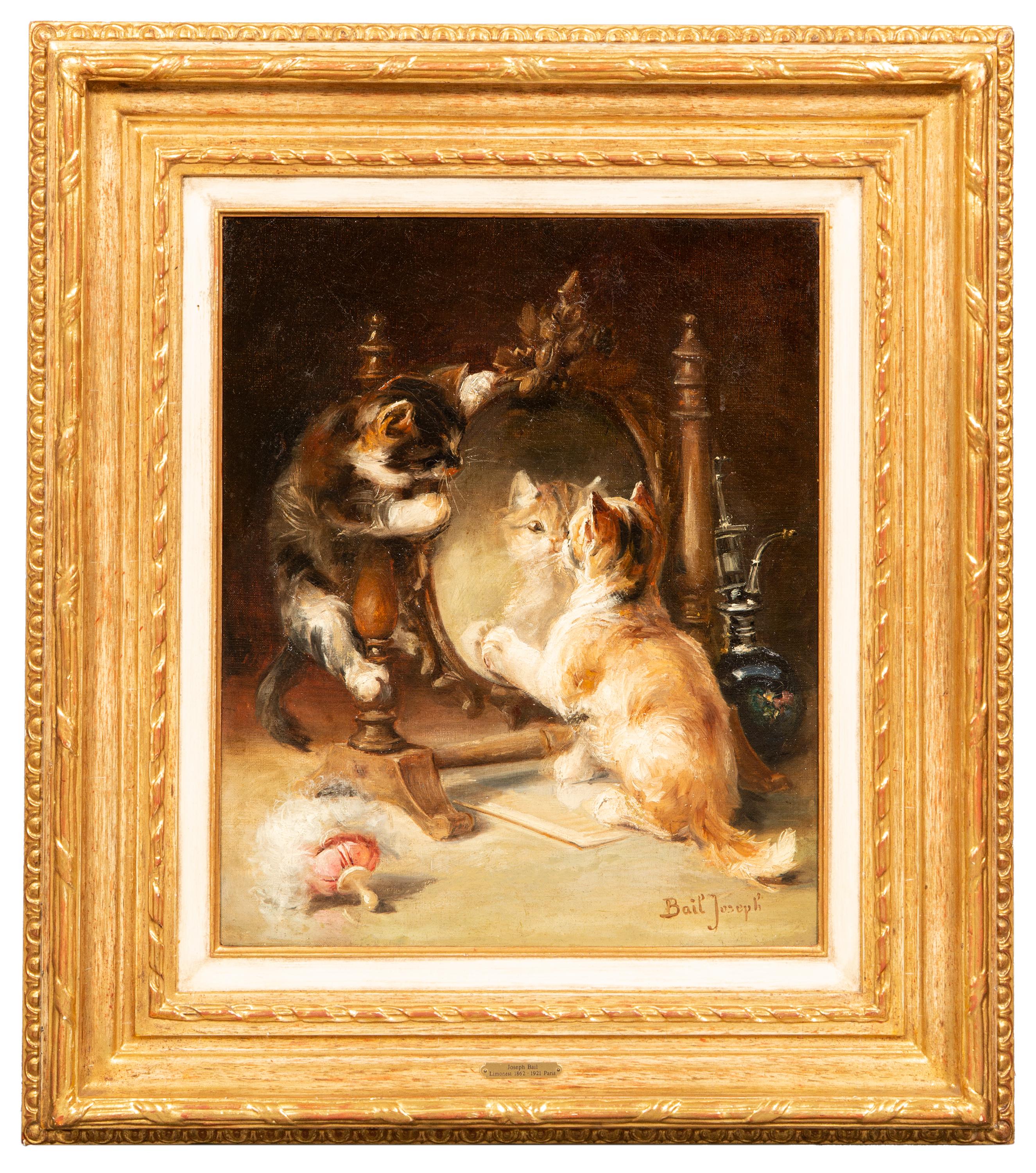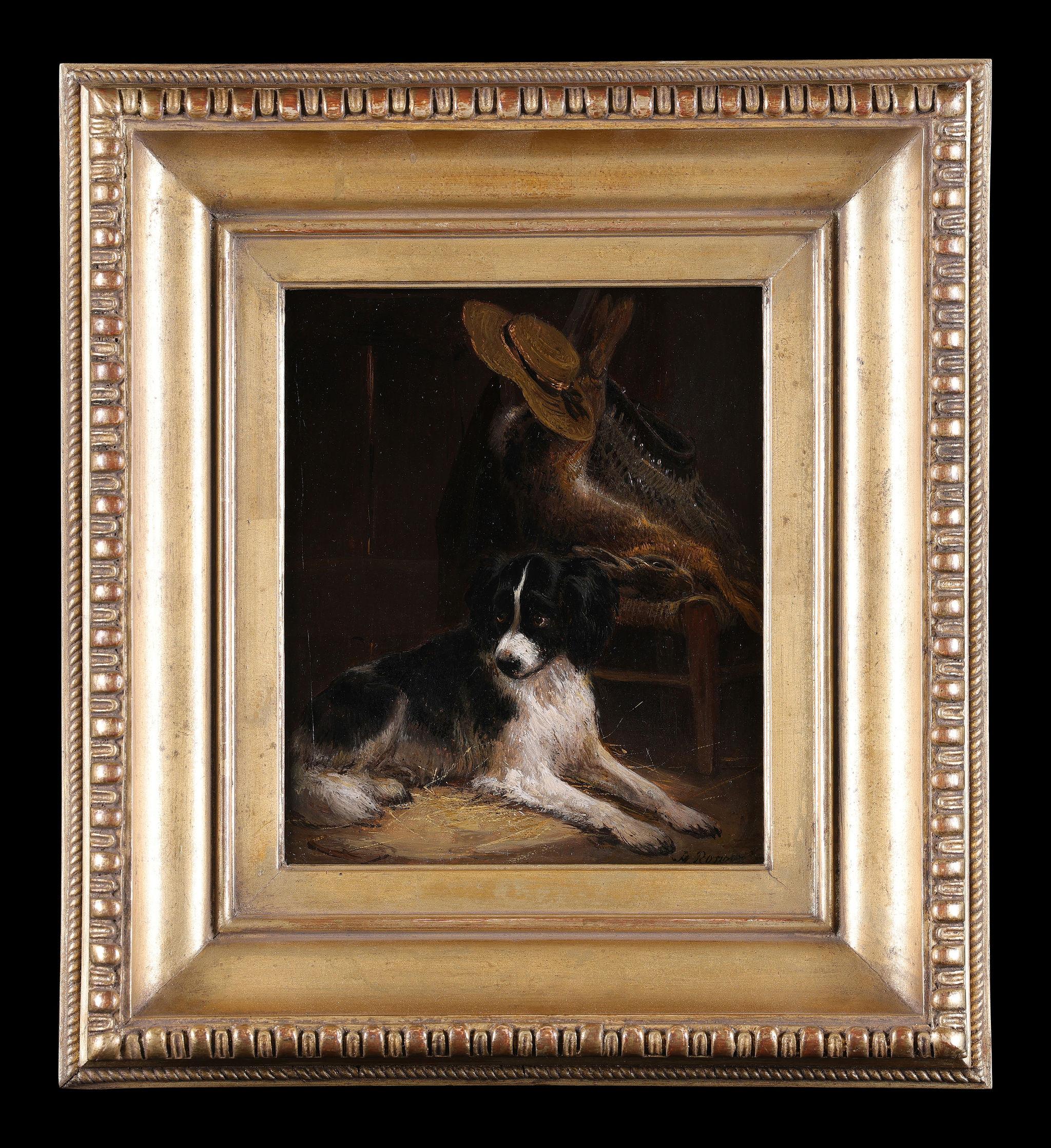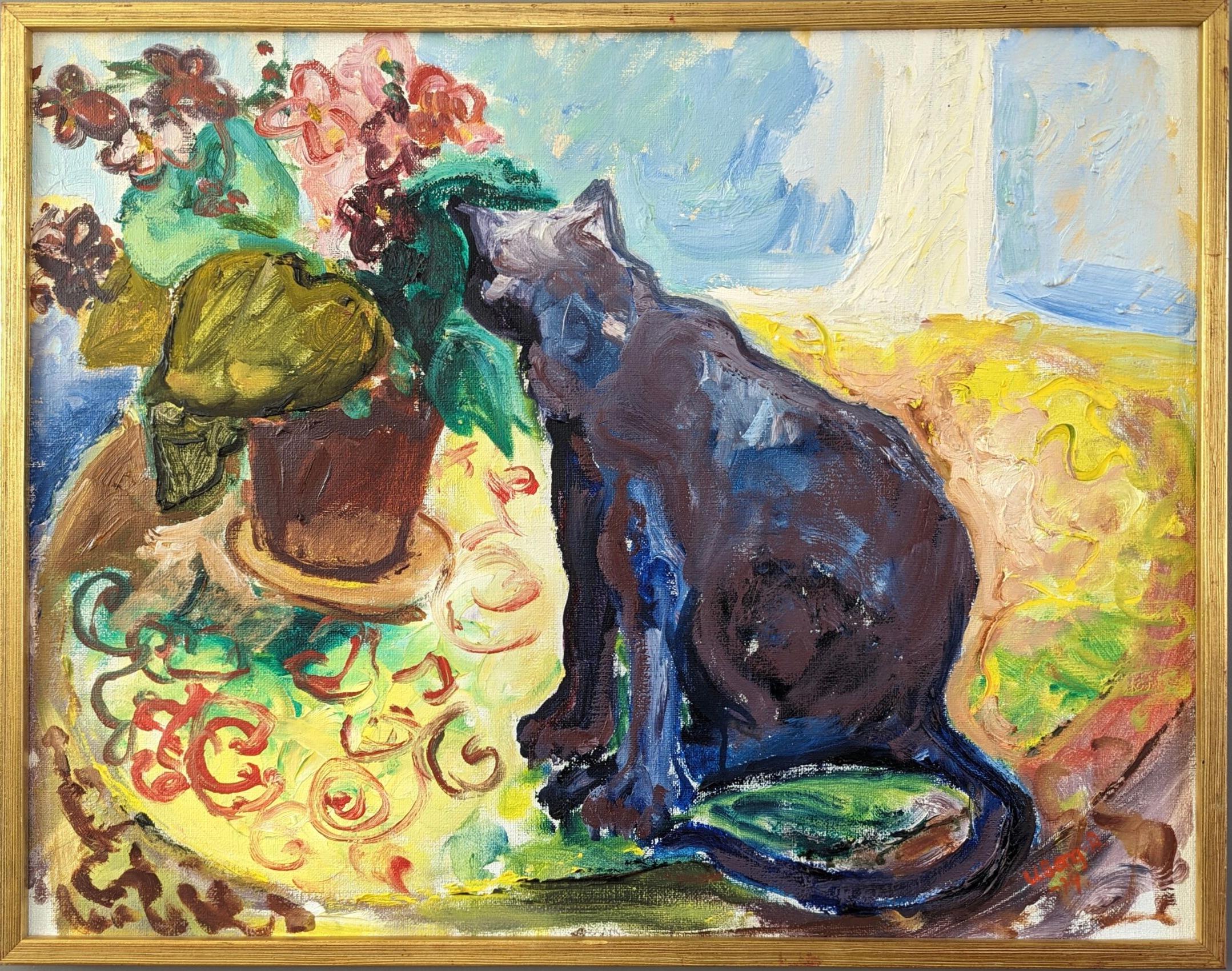Items Similar to Confrontation, Charles Van Den Eycken, Brussels 1859 – 1923, Belgian Painter
Want more images or videos?
Request additional images or videos from the seller
1 of 6
Charles Van Den EyckenConfrontation, Charles Van Den Eycken, Brussels 1859 – 1923, Belgian Painter1859 – 1923
1859 – 1923
About the Item
Confrontation
Van Den Eycken Charles
Brussels 1859 – 1923
Belgian Painter
Signature: Signed bottom right
Medium: Oil on canvas
Dimensions: Image size 28 x 21,50 cm, frame size 36 x 30 cm
Biography: Van Den Eycken Charles (alias Charles Duchene) was born in Brussels in 1859. He was an animal painter, mainly dogs and cats and interiors.
He was the son of Charles Van Den Eycken, Sr. who was his teacher. He was also a pupil of another master, Jos Stevens at the Brussels Royal Academy. He also attended the Louvain Academy of Fine Art. Van Den Eycken started by painting interior scenes, but was influenced by Joseph Stevens and concentrated almost exclusively on the representation of animals.
From 1881 he exhibited regularly at the Salons of Brussels, Liege, Ghent, Antwerp, as well as in Holland, Spain and Germany. He painted several paintings for Queen Marie-Henriette of Belgium, most notably of dogs. Van den Eycken was a member of the famous group l’Essor. He obtained many medals. He received an honourable mention in 1895, a rare honour for a Belgian artist.
Van Den Eycken died in Brussels in 1923.
Today, his paintings are highly sought after and he is considered one of the finest painters of cats and dogs. His works can be found in important private and public collections worldwide, including the Museum of Antwerp, Brussels and Kortrijk. In Antwerp Museum there is an oil painting depicting “Cats” (1911). Van Den Eycken is listed in the prestigious book titled “Deux Siecles de Signatures des Artistes”.
Literature:
PIRON, ‘De Belgische Beeldende Kunstenaars uit de 19de en 20ste eeuw’, Uitgeverij Art in Belgium, p. 1373
- Creator:Charles Van Den Eycken (1859 - 1923)
- Creation Year:1859 – 1923
- Dimensions:Height: 11.82 in (30 cm)Width: 14.18 in (36 cm)Depth: 2.76 in (7 cm)
- Medium:
- Movement & Style:
- Period:
- Condition:The painting is housed in high quality frame which is in excellent condition. This work is offered in ready to hang gallery condition, having been professionally cleaned and revised.
- Gallery Location:Bruges, BE
- Reference Number:1stDibs: LU2006211616812
About the Seller
5.0
Vetted Seller
These experienced sellers undergo a comprehensive evaluation by our team of in-house experts.
Established in 1998
1stDibs seller since 2022
14 sales on 1stDibs
Typical response time: 1 to 2 days
- ShippingRetrieving quote...Ships From: Bruges, Belgium
- Return PolicyA return for this item may be initiated within 14 days of delivery.
More From This SellerView All
- ‘Meal Time for all’ by Hermann Werner (1816 – 1905), signed and dated 1870By Hermann WernerLocated in Bruges, BEHermann Werner Samswegen 1816 – 1905 Düsseldorf German Painter ‘Meal Time for all’ Signature: signed lower right and dated ‘H. Werner. 1870 ' Medium: oil on canvas Dimensions: ima...Category
Late 19th Century Romantic Interior Paintings
MaterialsCanvas, Oil
- ‘Cats Playing around a Mirror’ by Joseph Bail (1862 – 1921), French PainterLocated in Bruges, BEJoseph Bail Limonest 1862 – 1921 Paris French Painter ‘Cats Playing around a Mirror’ Signature: signed lower right ‘Bail Joseph’ Medium: oil on canvas Dimensions: image size 45,5...Category
19th Century Romantic Animal Paintings
MaterialsCanvas, Oil
- “A Lady playing with a Cat” by Paul De Frick (1864 - Paris - 1935), dated 1896By Paul de FrickLocated in Bruges, BEPaul De Frick 1864 - Paris - 1935 French Painter “A Lady playing with a Cat” Signature: signed lower left and dated ‘P. de Frick. 96’ Medium: oil on canvas Dimensions: image size ...Category
Late 19th Century Impressionist Interior Paintings
MaterialsCanvas, Oil
- A Meal, Charles Van Den Eycken, Brussels 1859 – 1923, Belgian PainterLocated in Bruges, BEA Meal Van Den Eycken Charles Brussels 1859 – 1923 Belgian Painter Signature: Attributed to Charles Van Den Eycken Medium: Oil on panel Dimens...Category
19th Century Realist Animal Paintings
MaterialsOil, Wood Panel
- André Plumot, 1829 – 1906, Shepherds Couple with Herd in a River LandscapeLocated in Bruges, BEPlumot André Antwerp, Belgium 1829 – 1906 Belgian Painter Shepherds Couple with Herd in a River Landscape Signature: Signed bottom left and dated 1877 Medium: Oil on canvas Dimensi...Category
Late 19th Century Romantic Landscape Paintings
MaterialsOil, Canvas
- ‘Peasant Children walking the Donkeys’ by Edgar Bundy (1862 – 1922), dated 1885Located in Bruges, BEEdgar Bundy Brighton 1862 – 1922 London British Painter ‘Peasant Children walking the Donkeys’ Signature: signed lower right and dated ‘Edgar Bundy 1885' Medium: oil on canvas Dim...Category
Late 19th Century Romantic Animal Paintings
MaterialsCanvas, Oil
You May Also Like
- Waiting with the Day's RewardsBy Henriëtte Ronner-KnipLocated in St. Albans, GBSigned. Oil on Panel. Signature lower right. It is framed in the original antique gold leaf frame. HENRIETTE RONNER-KNIP Amsterdam 1821 - 1909 Brussels Henriette Ronner-Knip is ...Category
Mid-19th Century Romantic Animal Paintings
MaterialsOil
- Merry Goats: Juicy Pastoral. Oil painting with Goats . Farm animal artLocated in Zofingen, AGOn the canvas of this picturesque painting unfolds a marvelous spectacle - two cheerful goats immersed in the world of fresh nature. They chew on the succulent grass with ease and jo...Category
21st Century and Contemporary Post-Impressionist Animal Paintings
MaterialsCanvas, Cotton Canvas, Oil
- Global Warming rich color humor art topical subject birds and human interactionBy Stephen BassoLocated in Brooklyn, NYoil on stretched canvas signed an dated on reverse. Basso's highly original pastels and oil paintings are romantic yet thought provoking narratives. His whimsical works are alive wit...Category
2010s Neo-Expressionist Animal Paintings
MaterialsCanvas, Oil
- 1974 Vintage Mid-Century Interior Scene Cat Oil Painting - The Curious EncounterLocated in Bristol, GBTHE CURIOUS ENCOUNTER Size: 53.5 x 67 cm (including frame) Oil on Canvas A striking and lively composition, executed in oil onto canvas and dated 1974. The canvas bursts with energ...Category
Mid-20th Century Modern Interior Paintings
MaterialsCanvas, Oil
- "Nine Lives II" Oil on canvasBy Katherine FraserLocated in Philadelphia, PAThis piece titled "Nine Lives II" is an original artwork by Katherine Fraser and is made of oil on canvas. This piece measures approximately 23.5" x 27.5" a...Category
21st Century and Contemporary Contemporary Animal Paintings
MaterialsOil, Canvas
- "Interior of a Stable" William Hart, Hudson River School Antique, Boy and HorseBy William HartLocated in New York, NYWilliam M. Hart (1823 - 1894) Interior of a Stable Oil on canvas 17 x 12 inches Provenance William Macbeth Gallery, New York Mrs. Mabel Brady Garvan Collection Christie's New York, Sporting Art, November 28, 1995, Lot 116 Ann Carter Stonesifer, Maryland Estate of above Brunk Auctions, Asheville, North Carolina, January 27 2018, Lot 777 Exhibited New York, The Metropolitan Museum of Art, Life in America, April 24 - October 29, 1939, no. 123, illustrated. New York, Macbeth Gallery, 1892: Sixtieth Anniversary Exhibition, April 1952, p. 5, no. 18. Literature Turner Reuter Jr, Animal and Sporting Artists in America, Middleburg, Virginia, 2008, p. 306. Gary Stiles, William Hart: Catalogue Raisonné and Artistic Biography, no. 1126, illustrated. It should be noted that the Francis Patrick Garvan and Mrs. Mabel Brady Garvan collection, of which this painting was a part of, was one of the foremost American Art collections and now makes up a large part of the Smithsonian American Art Museum and the Yale University Art Gallery collections. Born in 1823 in Paisley, Scotland, William Hart emigrated with his parents to the United States at the age of nine and settled in Albany, New York. It was here that Hart first began his artistic training when he was placed under the tutelage of Messrs, Eaton & Gilbert, the prestigious coach-makers from Troy, New York. During this time, Hart learned how to decorate coach panels, covering them with either landscapes or figurative compositions. At the age of seventeen, he was eagerly contemplating an artist’s profession. Consequently, he left the mechanical trade of coach-making and began expanding his artistic pursuits to more refined endeavors. Hart followed coach-making with decorating window shades and later developed an interest in portraiture. Around 1840, he established his first formal studio in his father’s woodshed in Troy. There, he created many likenesses of individuals, affording him a nominal income. Once, he remarked that he felt prouder over his first fee of five dollars for painting a head then for the larger sums he would command later in his career. Nevertheless, his wages from portraits during this early period proved insufficient. Thus, he expanded into landscape painting, allowing him to barter his works or sell them for modest prices. In 1842, Hart moved to Michigan in an attempt to further his success; portraiture remained his primary means of support. Unfortunately, his experiences in the West were disappointing. Hart spent three years living a rough existence until he finally returned to Albany in 1845. Upon his return, he fully devoted himself to the art of landscape painting. Despite his failing health, he worked diligently to perfect his skill until 1849 when he traveled abroad to his native land of Scotland. This trip was made possible through the generosity of his patron and advisor, Dr. Ormsby of Albany. For three years, he studied in the open-air, creating brilliant sketches of the Scottish Highlands and the surrounding British Isles. Returning to Albany once more in 1852, Hart enjoyed improved health and was reinvigorated with purpose. The following year, he moved to New York and opened a studio, promoting himself as a specialist in landscape painting. Hart became a regular contributor to the National Academy of Design. His works received a great deal of attention from artists and connoisseurs alike, all of whom praised him for his fresh, self-taught style. In 1855, he was designated as an associate of the National Academy of Design; three years later he was elected to Academician. In 1865, he was unanimously chosen to be the first president of the Brooklyn Academy of Design. It was during his tenure there that he delivered his famous lecture The Field and Easel, which emphasized the distinguishing principles of landscape art in America. Hart argued that landscape painters should express the “look of the place” being depicted.Critics during the 1870s noted his sensitive balance between capturing a strict “real” interpretation of nature and that of a more “ideal” sentimental tone. For instance, in 1869, Putnam Magazine noted that Hart brought back “exquisite studies” of the surrounding Tappan...Category
19th Century Hudson River School Animal Paintings
MaterialsCanvas, Oil
Recently Viewed
View AllMore Ways To Browse
The Den
Painting Brussels
Belgian Painter
Belgian Master
Charles Dior
Charles Wells Painting
19th Century German Painter
Painting 19th Century Belgian
Oil Painting Belgian Master
Belgium Medal
Dior Romantic
Dior Cat
Dogs And Cats
Animal Oil Painting Dutch
Antique Cat Collection
Queen Marie
German Dogs
Dogs And Cats Painting





